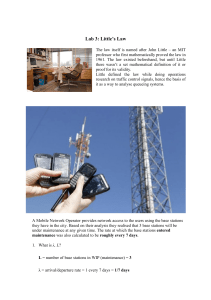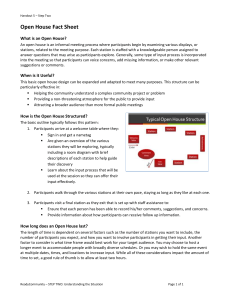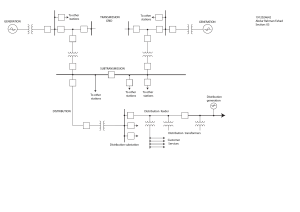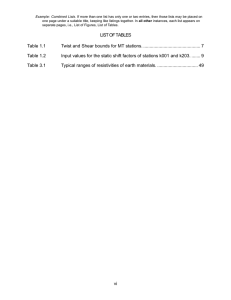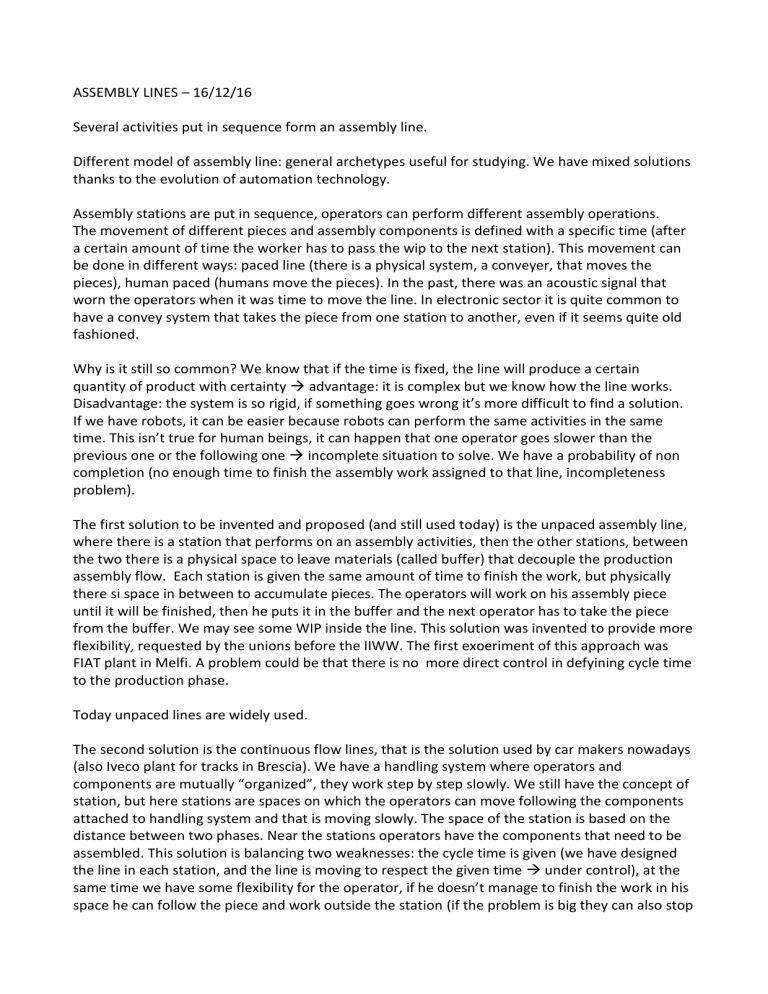
ASSEMBLY LINES – 16/12/16 Several activities put in sequence form an assembly line. Different model of assembly line: general archetypes useful for studying. We have mixed solutions thanks to the evolution of automation technology. Assembly stations are put in sequence, operators can perform different assembly operations. The movement of different pieces and assembly components is defined with a specific time (after a certain amount of time the worker has to pass the wip to the next station). This movement can be done in different ways: paced line (there is a physical system, a conveyer, that moves the pieces), human paced (humans move the pieces). In the past, there was an acoustic signal that worn the operators when it was time to move the line. In electronic sector it is quite common to have a convey system that takes the piece from one station to another, even if it seems quite old fashioned. Why is it still so common? We know that if the time is fixed, the line will produce a certain quantity of product with certainty advantage: it is complex but we know how the line works. Disadvantage: the system is so rigid, if something goes wrong it’s more difficult to find a solution. If we have robots, it can be easier because robots can perform the same activities in the same time. This isn’t true for human beings, it can happen that one operator goes slower than the previous one or the following one incomplete situation to solve. We have a probability of non completion (no enough time to finish the assembly work assigned to that line, incompleteness problem). The first solution to be invented and proposed (and still used today) is the unpaced assembly line, where there is a station that performs on an assembly activities, then the other stations, between the two there is a physical space to leave materials (called buffer) that decouple the production assembly flow. Each station is given the same amount of time to finish the work, but physically there si space in between to accumulate pieces. The operators will work on his assembly piece until it will be finished, then he puts it in the buffer and the next operator has to take the piece from the buffer. We may see some WIP inside the line. This solution was invented to provide more flexibility, requested by the unions before the IIWW. The first exoeriment of this approach was FIAT plant in Melfi. A problem could be that there is no more direct control in defyining cycle time to the production phase. Today unpaced lines are widely used. The second solution is the continuous flow lines, that is the solution used by car makers nowadays (also Iveco plant for tracks in Brescia). We have a handling system where operators and components are mutually “organized”, they work step by step slowly. We still have the concept of station, but here stations are spaces on which the operators can move following the components attached to handling system and that is moving slowly. The space of the station is based on the distance between two phases. Near the stations operators have the components that need to be assembled. This solution is balancing two weaknesses: the cycle time is given (we have designed the line in each station, and the line is moving to respect the given time under control), at the same time we have some flexibility for the operator, if he doesn’t manage to finish the work in his space he can follow the piece and work outside the station (if the problem is big they can also stop the line actually in some cases) it gives freedom to operators to work on their stuff. So in this station we are able to reduce the probability of non completion. These solutions provides opportunities to make an assembly line in a proper way. Said this, our interest is to work on the design of the line. The first design is aimed at deciding the number of stations and defying the time for each station, the second purpose is to design each single stations (by mechanical engineers). Our design is based on the fact that we have to decide how many stations (working on assembly operations), which will be the cycle time, and we have to balance the line. The design variable is the TIME as usual. Slide 3: minimum set of info to design, that is the list of operations (what we will doing, which are the assembly operations to include), which is the order of operations (assembly graph, it gives us the order, sequence, parallelisms and so on, to decide how to distribute the operations in stations). The assembly graph is not enough since we should know the time needed to perform activities. Here we have the biggest problem, that is that we don’t know the time. Most of the assembly activitites are still done by humans that work with different paces. We can describe time of huamns with a normal distribution (we need the average time and its standard deviation). Let’s take the example of IKEA chair and let’s imagine to design the line. We have three operations, and we need to find theirs average and their deviation standards. How to calculate those times? Trying to build it and measure the time. How many times do we need to register time? Several times. There are studies that certify times to perform standard activities (motion time measurement techniques). This info helps to forecast time needed to do an activities without estimate it. Part of motion time tech is also aimed to find which is the best way to perform activities to take the minimum amount of time. Process engineers go in details about the method of how assembly operations has to be performed. Once we have this info, we can start with the design of the line, we need to understand how many stations we need and how to divide the work among stations. In real life we have constraints space in plants, more or less skilled workers, more or less traditional facilities and so on). Which are the objectives that we want to achieve? We can be in a situation in which we want ti have the smallest number of stations given a certain cycle time, that is the time taken by the line to make a full circle. We can be in a situation where cycle time is given, and It is following from a strategic decision. We can be in a situation where we want to minimize the cycle time. Or I can be interested in minizimg the time wasted by the operators (in the handling line), or we want to minimize the probability of non completion (for a strategic decision or because of a specific market contests). Or I want to be sure that the cycle time is always respected. Or I can be interested in minimizing the expected costs, that is the trade off between not finishing the products and the cost of installing the station itself. We can have many different objectives according to the situation. The objective should be the first thing to set. Balancing constraints: vedi slide. We would like to have a line in which each single station is working within the cycle time and that all the cycle time is used: in that way all the operators will work for 100% of their time. The problem is that we are building physical products, we ae dealing with operators, each operations requires a specific amount of time. In practice, having 100% of efficiency is not the normal life. We have to distinguish from efficiency of the overall line and utilization of persons. Efficiency I consider the line as a single tube. Utilization of operator (efficiency on the single station level) I have the 5 min of my cycle time, I was able to do in that station a lsit of assembly operations till 4,5 min that operator is almost fully used. Let’s imagine that we have a line made by operators, 5 stations (5 operators, one per station) and 22 min of assembly time to divide among the different stations. The line itself will be used 22 min/25 (total cycle time), but how the single operator will be used? This is the kind of problem we have to solve. The designer of that line has to be sure to designing a line able to finish the work, knowing that humans can’t work at the maximum possible pace. We may decide that all the operators won’t work 100% of their time, but 90% of their time safe coefficient on the utilization rate (alfa). Or we can accept that one or more operators work more than the other, to increase the productivity of the lines. How could we decide this? When is it safer to assign less work? At the beginning or at the end of line? It’s a matter of managing the risk, if next to end of the line we are not able to finish it is risky, it’s better than the person at the end of the line is less used than the first ones. Our game is, given the time allowed for each station, to decide the allocation of operations in stations, in the proper order. The order to follow is given by the assembly graph. Remember that the CT in slide 10 is given!! If we have the amount of time needed to build a component, and the CT we can easily calculate the number of stations. We can have different orders because we may have different priority rules. We can have some bettere guidelines, reference procedures always based on this method of assigning operations but with a focus on optimization. We’ll see three methods based on technical objectives and based on info available. LECTURE 19/12 part 3 – MANCA LA PRIMA PARTE We need to see other three elements: Assembly lines can be different (paced, unpaced, continuous). The design method are independent on the types of line, they can be used anyway. Said this, some peculiarities should be mentioned. In Paced lines (given cycle time, and then material moved from one station to another with a certain step time) we have a different level of complexities than in unpaced lines. Unpaced assembly lunes were invented to be more flexible (for operators and for porudtcion variety), thanks to buffers that decouple the production flow (partial independence for workers). These unpaced lines were historically introduced to empower workers and to give them the physical possibilities to assemble partially different components, all part of the same family of products (multi model, or mixed model, assembly system). As a consequence, we may have some variability in the production flow in unpaced lines. Let’s imagine we have an unpaced line with a decoupling point. Operation is station 1 takes 60”, in the second station in the 40% of the cases, the activity takes 40”, but in 50% of the cases the activity takes 72” (for a different component probably), and in the 10% of the cases it takes 120”. This a multi model assembly line in an unpaced line (lean manufacturing). This case lead to be unbalanced in some cases (and to solve the unbalance, they put a buffer in the middle). Let’s imagine that we can’t change the assignment of operations to the station, what can we do? We have still do decide the dimension of the buffer, important to avoid inefficiency, to avoid blocks in the system (our buffer should be long and big enough to avoid to block the first station, that happens in case of 120”) and at the same time to avoid starvation of the second station (in case of 30”) problems of dynamism of the system. We have an empirical solution and a mathematical solution for this problem, but not in this course. We have just to remebr that the production capacity will increase with the increasing of the buffer, but it shouldn’t overcome the production rate. The second issue is about continuous line, invented in the 80s n the car industry to merge the advantages of both paced and unpaced systems. The most important thing to be defined is always the number of stations, remembering that the cycle time is a matter of the speediness of the line itself, that needs to be defined as weel. Moreover we have to decide the space, the length of each station. These lines are usually done with the possibility to change the speediness or the moving system. If the speed is high, we can expect that station are more (if I want to work faster, I have to use more resourcs) and the space dedicated to eaxh station is less. In case of fall of demand, I can reduce the number of station leaving more space to the remaining stations (more more flexible than unpaced). When the speed is high, the risk is no completion (workers have to work faster in a limited space). Let’s imagine a continuous flow line, how could we solve the completion? We could add a “hospital” station, with a skilled person that is able to do all the activities done before the hospital station (called jolly operators). Hospital station and jolly operator can also be distinguished, putting the jolly directly on the line. Another issue is continuous line is that we have to divide the space among the stations, leaving upstream and downstream space both to let workers work with more flexibility and to be used in case of changing in speediness. DESIGN OF ASSEMBLY SYSTEM PART 4 Assembly lines moved from a single model concept, to a multi model – mixed model concept. A single-model assembly line it’s possible to assemble only one kind of product useful if the demand is high with little variation. In case of customization variety, this model is not the most appropriate one. Multi-model vs mixed-model: Multi-model the line can produces different products but all the batches are made of the same products; old concept, not very used anymore. Mixed-model line in which at the same time I can have in sequence different products of different types. This is common since the 90s, especially in car industry. In terms of design, the most famous solution is the U-shaped lines introduce by Toyota, lean manufacturing, where operators can be easily interchanged. Multi-model and mixed-model formula have not to be studied!! Multi-model we have to calculate the number of the stations, we should work with a design activities to find a solution feasible for all the products to be done. We have also to consider the set up time, when designing this system. Mixed –model we have different products that require the same opratiosn but with different cycle time. We have two possibilities, one in the planning phase (to balance the scheduling phase in control, and to balance the stations), the other is working n the standardization concept (again from lean manufacturing). BI formula is not asked, just the main concept. ASSEMBLY SHOP (questions: what is it? What are the advantages?) Assembly shop are in the middle between fixed position (“stupid” solutions) and assembly line (much more complex). Assembly shop is the most used solution in this period. We have assembly operations to perform, instead of having one single fixed station, we decide to divide the work in shops (fixed position), where operators do some precise activities. Material is noved station by station, so it is a line. But it could happen that in case of high demand I have more parallel station for each phase. It was originally used in the car industry. This solution comes from the past, Volvo was the first one to apply it, then it was adapted to aeronautic sector, today it is quite fashionable because of a matter of flexibility, productivity. Today we are into the Industry 4.0, increasing in automation, especially AGV system, flexible automation. Assembly shops is perfect to implement more automatic solution that combine flexibility and productivity. Where assembly can be automatize? Assembly is still today a “manual” activity, because the human being is the most flexible solution that exists. Since the 70s automation has replaced some human activities, and this is happening still today. Some example of automatic solution are the vibrator, and other specialized machines, like the machines that produces wood products and packages for IKEA (manufacturing AND assembly automated system). Italy is the first producer in the world of machines that create packaging for food (near Reggio Emilia). A machine that create packages is manufacturing and assembly system (this is advanced manufacturing and advanced automation system).
